The AMD Ryzen Threadripper 3960X and 3970X Review: 24 and 32 Cores on 7nm
by Dr. Ian Cutress, Andrei Frumusanu & Gavin Bonshor on November 25, 2019 9:05 AM ESTCPU Performance: Encoding Tests
With the rise of streaming, vlogs, and video content as a whole, encoding and transcoding tests are becoming ever more important. Not only are more home users and gamers needing to convert video files into something more manageable, for streaming or archival purposes, but the servers that manage the output also manage around data and log files with compression and decompression. Our encoding tasks are focused around these important scenarios, with input from the community for the best implementation of real-world testing.
All of our benchmark results can also be found in our benchmark engine, Bench.
Handbrake 1.1.0: Streaming and Archival Video Transcoding
A popular open source tool, Handbrake is the anything-to-anything video conversion software that a number of people use as a reference point. The danger is always on version numbers and optimization, for example the latest versions of the software can take advantage of AVX-512 and OpenCL to accelerate certain types of transcoding and algorithms. The version we use here is a pure CPU play, with common transcoding variations.
We have split Handbrake up into several tests, using a Logitech C920 1080p60 native webcam recording (essentially a streamer recording), and convert them into two types of streaming formats and one for archival. The output settings used are:
- 720p60 at 6000 kbps constant bit rate, fast setting, high profile
- 1080p60 at 3500 kbps constant bit rate, faster setting, main profile
- 1080p60 HEVC at 3500 kbps variable bit rate, fast setting, main profile
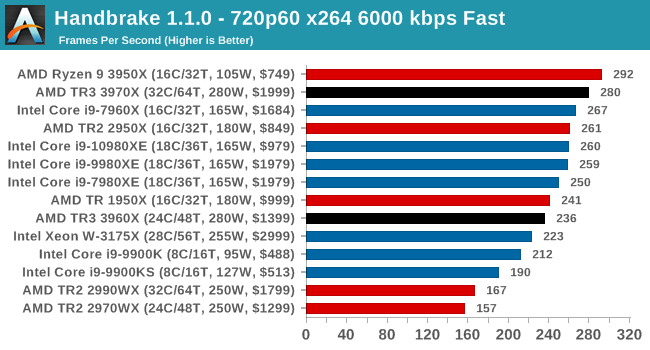
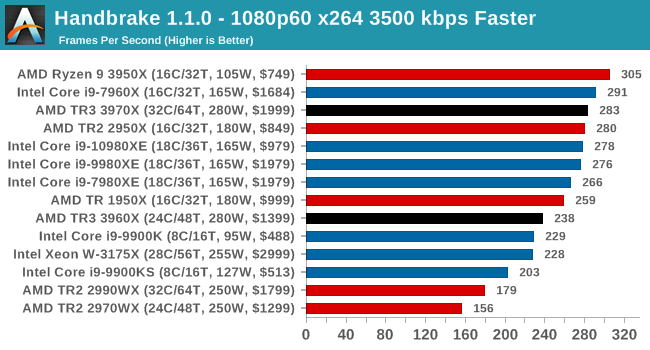

Video encoding is a little varied, based on the variable threaded nature. Certain encoding tests can be more memory sensitive here, or accelerated in different ways, or not scale well with more cores. Either way, TR3 performs a lot better than TR2, but the 3950X seems the best choice.
7-zip v1805: Popular Open-Source Encoding Engine
Out of our compression/decompression tool tests, 7-zip is the most requested and comes with a built-in benchmark. For our test suite, we’ve pulled the latest version of the software and we run the benchmark from the command line, reporting the compression, decompression, and a combined score.
It is noted in this benchmark that the latest multi-die processors have very bi-modal performance between compression and decompression, performing well in one and badly in the other. There are also discussions around how the Windows Scheduler is implementing every thread. As we get more results, it will be interesting to see how this plays out.
Please note, if you plan to share out the Compression graph, please include the Decompression one. Otherwise you’re only presenting half a picture.
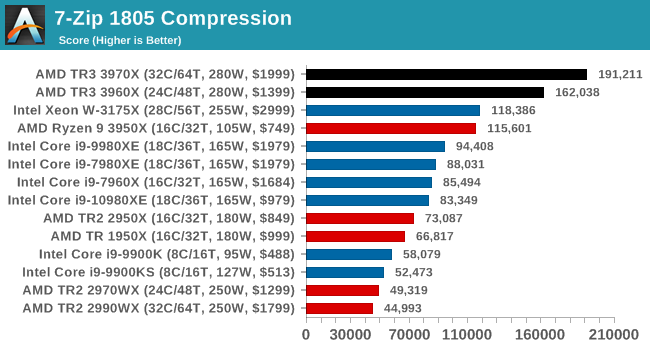
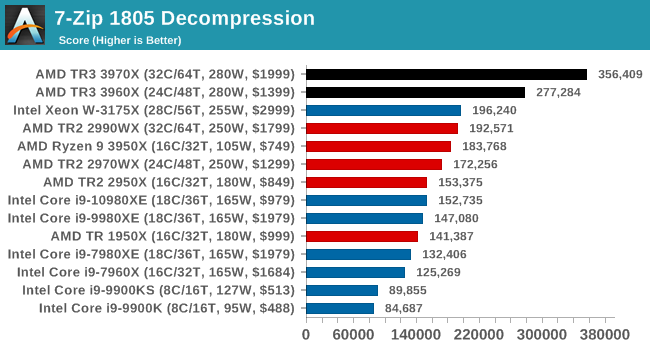
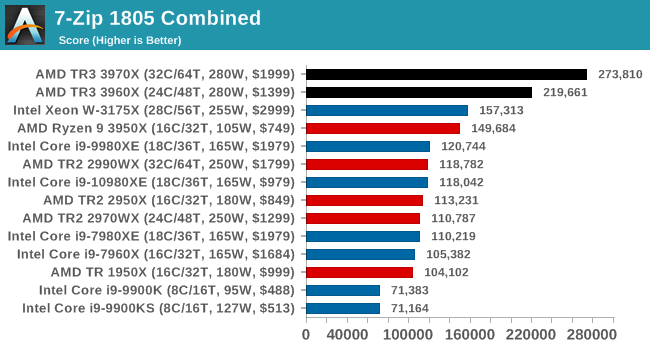
Easily parallel puts the TR3 well ahead of TR2 and Intel.
WinRAR 5.60b3: Archiving Tool
My compression tool of choice is often WinRAR, having been one of the first tools a number of my generation used over two decades ago. The interface has not changed much, although the integration with Windows right click commands is always a plus. It has no in-built test, so we run a compression over a set directory containing over thirty 60-second video files and 2000 small web-based files at a normal compression rate.
WinRAR is variable threaded but also susceptible to caching, so in our test we run it 10 times and take the average of the last five, leaving the test purely for raw CPU compute performance.
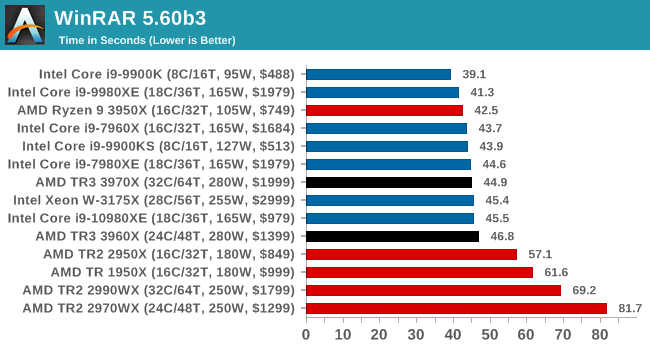
WinRAR is a variably threaded application, and both TR3 processors perform in the same ballpark as anything from Intel. Ideally we should have seen them streak ahead, but we seem to be at a point where CPU frequency or core counts are the limiting factor. At least with Zen 2, there are no issues as there was with Zen 1/Zen+.
AES Encryption: File Security
A number of platforms, particularly mobile devices, are now offering encryption by default with file systems in order to protect the contents. Windows based devices have these options as well, often applied by BitLocker or third-party software. In our AES encryption test, we used the discontinued TrueCrypt for its built-in benchmark, which tests several encryption algorithms directly in memory.
The data we take for this test is the combined AES encrypt/decrypt performance, measured in gigabytes per second. The software does use AES commands for processors that offer hardware selection, however not AVX-512.











245 Comments
View All Comments
MarkusB. - Tuesday, November 26, 2019 - link
I dont think and I dont hope that Intel is dead here. I do love the current status to be honest. Let them fight on the same level. I dont care if I use a AMD or an Intel chip at the end of the day. Let the CPUs get cheaper and more powerfull with a nice and working competition :) ... Intel will react on this and maybe in a few years Intel is back, just to be chased again by AMD. THAT´s how it should be ;)azfacea - Tuesday, November 26, 2019 - link
intel won in 2005 because GloFo (part of amd then) couldnt keep up. now its reverse with TSMC. intel is dead for goodZizo007 - Tuesday, November 26, 2019 - link
My last Intel was the 4770K which was a great CPU. Nowdays AMD is dominating CPU performance and I am very happy with my 4Ghz 1800X. I saw no reason to upgrade the 4770K until Ryzen has launched. Intel will catch up but this might take a year or two. Intel won't be out of business for sure and that would be bad for us since AMD will raise their prices if there is no competition. In the other hand Intel is entering the GPU market which will help them. AMD is currently suffering in the GPU market as they only have the 5700XT which cannot keep up with the RTX series and Big Navi needs a miracle to even match the old Turing architecture; Big Navy won't even be released this year.Dr. Denis - Tuesday, November 26, 2019 - link
It would be nice if AMD released an entry level TR3 with 16 cores at the $900-$1000 price point. It would be like a 3950x but with the extra memory bandwidth and pcie lanes, which are really important in a variety of workloads. I think the reason why this configuration doesn't exist yet is because AMD has "Ryzen" the HEDT bar to high making the market for it too small. What do you think?azfacea - Tuesday, November 26, 2019 - link
pointless product. if you are building a 3000 usd workstation you can afford 1400. if you just want pcie lanes, there are some older gen thread rippers out there for 200 usd. AMD should focus on rolling out 2 -- and not 1 -- 7nm APU dies. one quad core for 15w and below and a 8 core apu for 15 inch laptops and larger, 25W+Dr. Denis - Tuesday, November 26, 2019 - link
Well... The APU market is another story since its the only place where AMD is still behind Intel in efficiency, and consequently, in performance. We all expect zen2 will revert this in 2020.Back to the workstation side, it seems now that the best option for a ~16 core system for memory bound applications is the good old Skylake
CyrIng - Tuesday, November 26, 2019 - link
Thank you AnandTech for this review.Talking about HEDT processing, why don't include Linux benchmark results ? Do games scores make a difference for a super computer...
Samus - Wednesday, November 27, 2019 - link
I need this to decompress my torrents. I'm tired of waiting 10 seconds for a bluray to extract and would rather wait 4 seconds...it's movie time!335 GT - Wednesday, November 27, 2019 - link
AMD's biggest problem now is making enough of these. Every EPYC is sold before it leaves the fab and I suspect the same is happening with the desktop chips.ballsystemlord - Wednesday, November 27, 2019 - link
No spelling or grammar errors found! Nice work, guys!